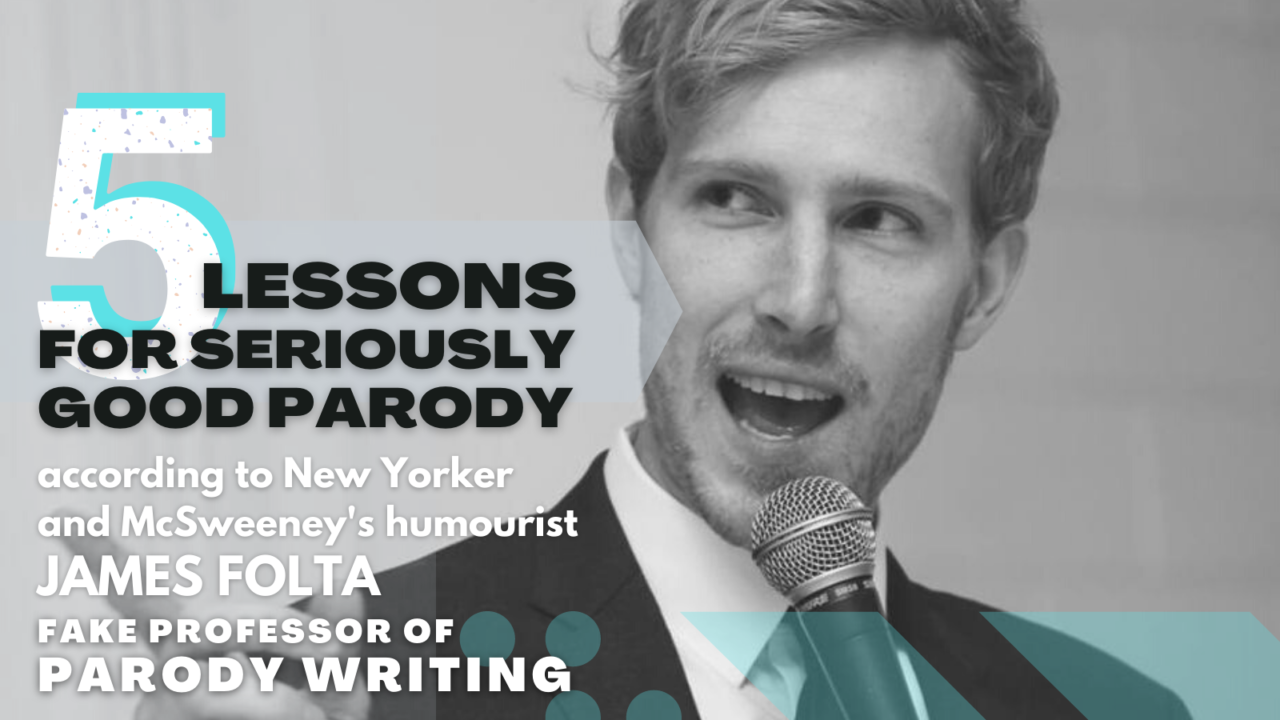Muses come in many forms. For James Folta, it was the gap-toothed rapscallion Alfred E. Neuman from MAD magazine that inspired him to chase a career as a writer of parody.
Since then, James has found success with a long list of bylines hanging on the humorous pages of McSweeney’s, The New Yorker, National Lampoon, Funny or Die, and Esquire. Credits like these don’t come easy, but they do come to writers who take parody writing seriously and learn from the best.
Starting Thursday, May 19th, James will help a group of writers develop their own short parody pieces from concept to polished draft. (Space is very limited. Email us if you have any questions or to request a payment plan.)
We caught up with James to learn how he fell in love with the genre, common mistakes emerging parody writers make and tips for pitching funny pieces to serious editors.
Can you tell us about one of the first parody pieces that turned you on to the genre?
As a kid, I was a big fan of parody on TV and in movies — parody commercials on SNL, genre send-ups on All That, Space Balls, Austin Powers, and on and on. But the idea that that sort of humor could exist in print wasn’t really apparent to me until I flipped through issues of MAD magazine at the library.
I think the light-bulb moment for me was seeing a big comic parody of The Phantom Menace in MAD when I was in middle school. I remember it being so wide-ranging and silly, and every panel of the comic was filled with jokes and gags. As an obsessive preteen nerd, it was exactly the sort of comedy that really got my creative gears turning.
What is a common problem or pitfall that emerging parody writers encounter?
I think there’s a tendency to not fully commit to the parody. There’s a lot of breaking of the fourth wall, or moments where the writer is winking or speaking directly to the reader in their own voice, as opposed to the voice of what they’re parodying, which can undercut the joke.
There are some artful ways to deliver information and jokes without selling out your parody, and especially for some satire, it can be important to show a peek behind the mask at times, to make sure a reader isn’t misinterpreting your work. But it takes some practice and craft to do that while not compromising the logic of your parody.
Editors are people too, and contrary to what you might hear, their job isn’t just to reject work and crush dreams. Editors want you to succeed!
What is a key to writing parody well?
One thing I always remind myself is to leave no stone unturned when I’m looking for jokes in a parody piece. Taking the time to examine as many aspects and angles as possible of the thing you’re parodying is going to lead to a better piece.
Getting beyond the obvious elements to find less evident details to have fun with will not only lead to a more interesting piece, but it’s also a great way to uncover ways to surprise your reader.
What are some unusual places that ideas for your parody writing have come from?
I try to always keep my antenna up for funny things in my day-to-day, so ideas tend to pop up in surprising places more often than not.
A recent and particularly unexpected idea hit me a couple of years ago when I was waiting for the results of a COVID test. The pharmacy seated me next to a rotating rack of road maps, and staring at them for the 15 minutes it took for my rapid test to finish got me thinking about maps, and how I might use that format for something fun.
It inspired me, along with the very funny Lucas Adams, to create a big, fold-out map/atlas of the made-up Valentine’s Day Island.
And my test was negative!
What tips do you have for pitching parody pieces to publications?
I have pretty much the same advice for pitching anything: Do your research ahead of time to make sure that the publication is going to be interested in the kind of thing you’re pitching.
Be polite and to the point with your emails — editorial work involves a ton of emails, and you want your pitch email to be a welcome addition to what is likely an already overstuffed inbox.
And remember that there’s another person on the other end of the line. Editors are people too, and contrary to what you might hear, their job isn’t just to reject work and crush dreams. Editors want you to succeed!
Are you interested in taking Jame’s course? Here’s what you need to know!
COURSE SCHEDULE: Thursdays, May 19 – June 2, 2022, and Fri., June 3, 7pm–9pm ET (4pm–6pm Pacific)
Learn how to write parody for the likes of The New Yorker magazine and McSweeney’s in this course with writer, editor and comedian James Folta. Over the course of three weeks and four classes, we’ll discuss how to create longer and shorter print parody projects, how to write close to the voice and format of what you’re parodying, and how to use parody as a way to strengthen your humour writing. We’ll analyze parody, discuss pieces together, and write and workshop your work. You’ll get an introduction to terminology and techniques, and leave class with a draft of a short parody piece. (Some humour experience is preferred, but not required.)
In addition to receiving feedback on your short parody pieces, his lectures will cover:
- Understanding what makes good parody
- How parody is a useful lens for thinking about and writing all short humour
- How to come up with ideas for parody pieces
- Techniques for planning and outlining
- A workable draft for a short parody piece, or a plan for a longer project
CAPACITY: limited to 16 students
RECOMMENDED PREREQUISITE: This is an introductory course intended for committed students. Some humour experience preferred, but not required. Please be on time, meet your deadlines, and read other classmates pieces to workshop together. If you’re unsure whether this course is for you, ask us at info@pandemicuniversity.com.

